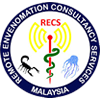Naja sputatrix
Taxonomy
-
Kingdom
-
Phylum
-
Class
-
Order
-
Family
-
Genus
-
Specific Epithetsputatrix Boie, 1827
-
Common Name
- Equatorial Cobra (English)
- Equatorial Spitting Cobra (English)
- Indonesian Cobra (English)
- Javan Spitting Cobra (English)
- Southern Indonesian Spitting Cobra (English)
- Ular Kobra (Bahasa Indonesia)
- Ular Sendok (Bahasa Indonesia)
- Ular Senduk Indonesia (Malay)
-
ResidentialNon-Native
Description
The Javan Spitting Cobra is a highly venomous snake that is often found in the Jabodetabek area, Indonesia (Rusli et al., 2016). This snake is able to survive and even thrive in the city. When threatened, this snake will spread its hood and sometimes also spit venom to a distance of up to 2 m. The cobras often lack clear markings and do not always spread their hood, so the Javan Spitting Cobra are frequently mistaken for non-venomous snakes.
Habits
| No | Part | Habit | |
|---|---|---|---|
| 1 |

|
Arboreal — Spend the majority of their lives in trees.
|
|
| 2 |

|
Oviparous — Reproduction through production of eggs that have membranes and/or shells.
|
|
| 3 |
Terrestrial — An animal that lives on/near the ground or a plant that grows on/in/from land
|
||
| 4 |

|
Venomous — Capable of injecting venom by means of a bite or sting.
|
Assessment
| Year Published | Assessment | Red List Category | Version |
|---|---|---|---|
| 2012 | IUCN Red List of Threatened Species |
Least Concern (LC)
|
3.1 |
Emergency Contact
Biodiversity Experts
| Profile | |
|---|---|
|
Amirrudin Bin Ahmad (Dr.)
Universiti Malaysia Terengganu (UMT)
|
Amphibians, Dragonflies and Damselflies, Fishes, Reptiles,
Biodiversity, Data Analysis, Digital Sequence Information (DSI), Living Modified Organism (LMO), Marine & Coastal, Protected Areas & Invasive Alien Species
|
|
Chen Pelf Nyok (Dr.)
Turtle Conservation Society of Malaysia (TCS)
|
Turtle, Tortoise, and Terrapin (Ecology), Reptiles (Ecology),
Biodiversity, Conservation, Education & Environment
|
|
Kaviarasu Munian (Mr.)
Forest Research Institute Malaysia (FRIM)
|
Reptiles (Ecology), Amphibians (Ecology), Fishes (Ecology),
|
|
Lim Boo Liat (Dr.)
|
Reptiles (Ecology), Rodents (Ecology), Amphibians (Ecology),
Biodiversity, Ecosystems & Invasive Alien Species
|
|
Mohammad Shahfiz Azman (Mr.)
Forest Research Institute Malaysia (FRIM)
|
Amphibians, Mammals, Birds, Amphibians, Reptiles,
Awareness, Biodiversity, Conservation, Ecosystems, Environment, Forest, Landscape, Law and Policy, Management, Protected Areas, Science, Systematics, Invasive Alien Species, Like-Minded Megadiverse Countries (LMMC), National Policy on Biological Diversity, Policy, Research and Development (R&D) & Zoonotic
|
|
Mohd Abdul Muin Bin Md Akil (Mr.)
Universiti Sains Malaysia (USM)
|
Amphibians, Birds, Reptiles, Snakes,
Biodiversity, Conservation, Evolution, Genetics, Molecular, Protected Areas, Climate Change & Invasive Alien Species
|
|
Mohd Uzair Rusli (Assoc. Prof. Dr.)
|
Turtle, Tortoise, and Terrapin, Reptiles,
Conservation, Data Analysis, Ecology & Marine & Coastal
|
|
Mohd Zulfadli Bin Mohd Arshad (Mr.)
Department of Wildlife and National Parks (PERHILITAN)
|
Rodents (Taxonomy), Reptiles,
Molecular, Biodiversity & Science
|
|
Norhayati Binti Ahmad (Prof. Dr.)
Universiti Kebangsaan Malaysia (UKM)
|
Frogs and Toads, Snakes, Amphibians, Reptiles,
|
|
Teo Eng Wah (Dr.)
University of Malaya (UM)
|
Reptiles, Amphibians,
Invasive Alien Species
|
References
- National Action Plan on Invasive Alien Species 2021-2025, 2021. Ministry of Agriculture and Food Industry & Ministry of Energy and Natural Resources, Malaysia. pp. 84. — [ Adobe PDF (PDF) ]
- Das, I. (2012). A Naturalist's Guide to the Snakes of South-east Asia : Including Malaysia, Singapore, Thailand, Myanmar, Borneo, Sumatra, Java and Bali. John Beaufoy Publishing, Oxford, England. pp. 70-71; 160 pg.
- Marlon, R., Supriatna, J., Liswanto, D., Baskoro, K., Putra, S. & Patty, H.R. (2014). Panduan Visual dan Identifikasi Lapangan: 107+ Ular Indonesia. Indonesia Nature & Wildlife Publishing, Indonesia. pp. 251.
- Rusli, N., Marlon, R., Lilley, R., Ekariyono, W. & Laister, A. (2016). Mengenal Ular Jabodetabek - Snakes of Jakarta and Its Surroundings. Ciliwung Reptile Center, Jakarta, Indonesia. pp. 168.
- Akta Pemuliharaan Hidupan Liar 2010 (2010) — [ Adobe PDF (PDF) ]
- Akta Perdagangan Antarabangsa Mengenai Species Terancam 2008 (2008) — [ Adobe PDF (PDF) ]
- International Trade in Endangered Species Act 2008 (2008) — [ Adobe PDF (PDF) ]
- Wildlife Conservation Act (2010). Laws of Malaysia Act 716 — [ Adobe PDF (PDF) ]
- World Wildlife Trade Report 2022. CITES Secretariat, Switzerland. — [ Adobe PDF (PDF) ]
- Krishnasamy, K. & Zavagli, M. (2020). Southeast Asia: At the heart of wildlife trade. TRAFFIC, Southeast Asia Regional Office, Petaling Jaya, Selangor, Malaysia. — [ Adobe PDF (PDF) ]
Publications
Acknowledgements :- Ms. Aida Salihah Binti Abu Bakar, Ms. Nurul Aimi Amirah Binti Mohd Zaki, Ms. Siti Zubaidah Binti Abdul Latif, Mr. Tan Kok Kiat & Mr. Yasser Mohamed Arifin
Species Citation :- Naja sputatrix. Malaysia Biodiversity Information System (MyBIS). Accessed via https://www.mybis.gov.my/sp/48937. [Retrieved 19 April 2024].
Feedback :- If you see any errors or have any questions or suggestions on what is shown on this page, please provide us with feedback.

